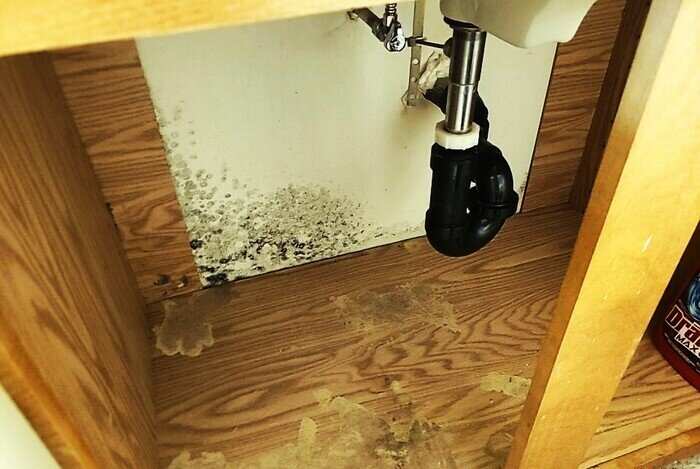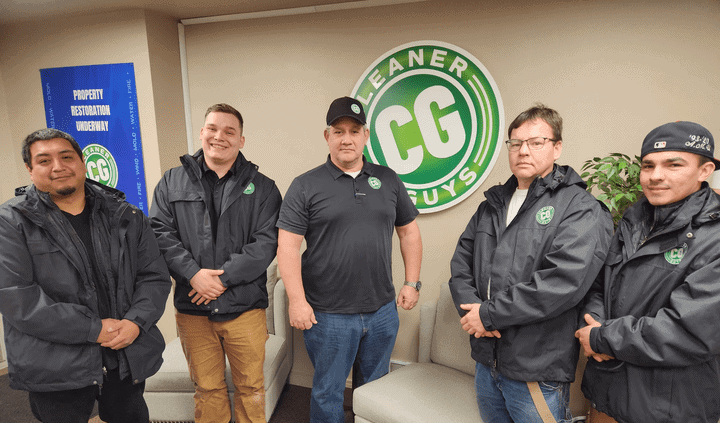Finding mold in an apartment is so stressful, whether you’re the tenant or the landlord! Where did it come from? Can you fix it yourself? Is it the landlord’s duty to fix it, or the tenant’s? All these questions and more are answered right here, by real experts on the matter: professional mold removers. Cleaner Guys has been remediating mold in apartments for decades, and we can guide you through all the ins and outs of what causes mold in an apartment, and what to do about it.
Table of Contents
- What is Mold?
- What Causes Mold in an Apartment?
- Top 10 Causes of Mold in Apartments
- How Do You Stop Mold from Growing in an Apartment?
- How Do You Clean Mold in an Apartment?
- More Resources
What is Mold?
Mold is a fungus, and it grows wherever it can find moisture, oxygen, and a food source it can absorb. This means that mold is most commonly found in areas with high levels of condensation or humidity, or anywhere there is water damage, like a leak or a flood.
Mold spores are floating around in the air all the time, indoors and outdoors, just like dust particles and bacteria. People don’t get sick from the spores usually floating around in the air because the concentration of spores is too low to cause a reaction in the body. However, wherever mold spores find excess moisture, like from a leak or condensation, they will land and begin to root and grow. Once mold starts rooting and growing on a surface, it begins releasing its own spores. This greatly increases the concentration of mold spores in the air, which is why people living near mold growth can get mold sickness.
What Causes Mold in an Apartment?
Mold grows anywhere there is moisture, oxygen, food, and warmth. Only the first 3 are necessary, but mold tends to grow faster where there is warmth and humidity. The average well-maintained apartment unit does not have enough moisture present for mold to take root. That’s why mold almost always starts growing after some sort of water damage. As soon as there is excess moisture in an area, mold can take less than 48 hours to grow. The following are the top 10 sources of moisture that cause apartment mold, in our experience.
Top 10 Causes of Mold in Apartments
- Unaddressed leaks. Slowly leaking pipes often aren’t discovered or addressed for a long time, and that’s why they are the #1 primary source of mold in apartments. They most commonly occur inside sink cupboards (see photo below).
- Poor ventilation. Mold spores settle and root more easily in stagnant, warm, unmoving air.
- Leaking appliances. The water supply lines of refrigerators, dishwashers, and washing machines often cause widespread mold growth, because those appliances are rarely if ever pulled away from the wall.
- Burst pipes from not winterizing. Frozen pipes bursting is an extremely common source of water damage and mold, and can only be mitigated by knowing how to winterize your home against freezes.
- Overflow/flood damage. Overflowed toilets or sinks are a pain to clean up, but most people don’t realize that that water can soak into the floor and walls, causing water damage and mold growth you can’t see!
- Dusty or damp HVAC shafts. Mold often breeds inside ventilation shafts, because they’re dusty, dark, and sometimes damp, and no one checks there.
- High humidity. Humidity creates excess moisture and warmth, both of which mold needs to grow.
- Malfunctioning water heater. A leaking or burst water heater is a very common source of mold.
- Irregular or insufficient cleaning. Not cleaning behind every appliance and in every crevice can often lead to mold growth in out-of-sight places.
- Damp or dirty clothing or clutter. Mold can grow in old damp cardboard boxes and textiles that haven’t been touched in a long time. Time for some spring cleaning!

How Do You Stop Mold from Growing in an Apartment?
Now that you know all the most common things that can cause mold, how do you prevent them from happening? These are the steps we strongly recommend to avoid mold in the future.
- Keep indoor humidity low. We agree with the CDC’s recommendation to keep your indoor humidity ideally lower than 50%. You can achieve this either with proper ventilation or a dehumidifier. Remember: mold needs moisture to grow, so don’t give it any!
- Take care of leaks immediately. They won’t go away on their own. If you’re a tenant, call your landlord about every leak right away. If you’re a landlord, stay on top of leaks! Treat every one like it could cost you thousands of dollars of damage if you don’t fix it right away. Because it could.
- Check behind and under large appliances regularly. Behind and under refrigerators, dishwashers, and washing machines are some of the most common places we have to remove mold. Pull them out and check at least every couple of months.
- Ventilation, ventilation, ventilation! Try to have some kind of airflow in every room. Ceiling fans, freestanding fans, and even opening a window will do. Stagnant air encourages mold growth.
- Regular, thorough cleaning. Mold feeds on organic materials like dust and crumbs. Cleaning all those away makes your home more inhospitable to mold.
- Check inside your HVAC shafts regularly. Carefully unscrew the ventilation covers (while the HVAC is off) and shine a flashlight down there sometimes. It only takes 5 minutes to check for mold this way!
- Know how to winterize your apartment! Knowing how to prevent your pipes from freezing is crucial if you want to avoid dealing with a burst one. Trust us, it’s not pretty. Learn how to prevent frozen and burst pipes in your apartment here.
How Do You Clean Mold in an Apartment?
Unless the area of mold growth is extremely small, we strongly advise against attempting to remove mold yourself. If the mold covers less than a 1 square foot area, you may be able to clean it off yourself with vinegar or a fungicide. We strongly recommend against using bleach on mold.
If, however, the mold covers more than 1 square foot, the only wise choice is to leave the removal to professionals. This is because however much mold you can see, there is usually a lot more inside and behind the material that you can’t see. Home remedies like vinegar cannot penetrate deeply enough to completely kill widespread mold like that.
Removing widespread mold usually requires safely removing and properly disposing of all mold-infested materials, and cleaning the area thoroughly with chemical solutions that will actually kill the mold. Most untrained laypeople cannot do these steps safely or thoroughly enough, because they don’t have the professional training and equipment of a professional mold removal expert.
Additionally, no one but a mold expert can determine whether the mold is an extremely toxic species, or a fairly harmless one. A layperson attempting to remove mold that they don’t know is extremely toxic can lead to terrible side effects and sickness.
More Resources
Our full blog is an almost endless source of information for all your water damage, fire damage, and mold damage questions! Here are just a few articles that you may find useful if you’re dealing with mold in an apartment:
➜ “Is My Landlord Responsible for Mold, or Am I?” Answered by Experts
➜ Is Mold in an Apartment Dangerous? Find out here!
➜ Sneaky Signs of Mold in an Apartment
Don’t miss checking out our full blog! You’ll find answers and solutions to problems you haven’t even thought of yet!
If you find yourself in the unfortunate position of needing a professional mold removal company in Western Washington State, consider Cleaner Guys as a high-quality, well-trusted option. We’re proud to boast award-winning customer service, lower prices than others, and top-notch workmanship! Contact us today through the menu at the top of your screen.

Disclaimer: This article is for informational purposes only. No part of this article is medical or legal advice, and may not be used as such. For all serious medical matters, consult your doctor. For all serious legal matters, consult your legal advisor. This article contains Cleaner Guys’ experience and opinions only.


